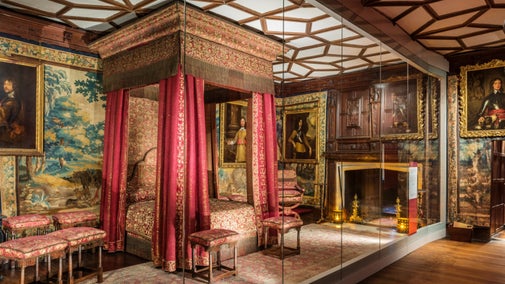
Knole's collections
Explore the objects and works of art we care for at Knole on the National Trust Collections website.

Knole is home to one of the rarest collections of Stuart-era furniture, paintings, objects and textiles. The collection is incredibly well preserved thanks to Knole's first owner, Thomas Sackville, deciding to showcase his treasures from acquiring the estate in 1605.
Thomas Sackville’s position as Lord Treasurer allowed him to employ the finest craftsmen from the Department of the King’s Works to produce Knole’s Jacobean interiors.
The royal offices held by subsequent generations of the Sackville family gave them the right to remove unwanted state furniture from the royal palaces. The quality and rarity of these pieces was recognised early on, both by the family and by interested visitors, and the furniture, tapestries and beds removed from the royal apartments were put on display at Knole.
The collection at Knole includes more than 300 paintings by 17th and 18th-century masters, many commissioned and collected by Sir John Frederick Sackville, 3rd Duke of Dorset.

The finest collection of 17th-century English upholstered furniture in the world is on display at Knole. Much of it was made for the royal palaces of the ruling Stuart dynasty and is of the highest quality. The objects on display are the combination of several separate collections.
Read more about the collection of furniture at Knole.
In addition to its rare Stuart royal furniture, Knole is famous for its remarkable collection of silver, on display in the King’s Room since 1706.
Silver furniture was made in England from around 1660 until around 1710. Apart from the set at Knole only two other sets survive in England today, one made for Charles II and the other for William III, both of which are in the Royal Collection.
One of the highlights is a silver table, decorated with images of fruit and foliage. The central oval panel of decoration portrays a musical contest between the Classical gods Pan and Apollo.
A surviving bill reveals that the table was made in England in 1680 by the prestigious Anglo-Dutch cabinetmaker Gerrit Jensen for Frances Cranfield, Countess of Dorset (1622–87).
The tapestries at Knole are some of the finest in the National Trust’s collection. Many were acquired by the 6th Earl of Dorset from Whitehall Palace in 1695.
While the tapestries at Knole have been cared for and admired for centuries, over time some were recycled and made into cushions and seat covers. Although it’s disappointing to lose the complete tapestries, this gives us a fascinating glimpse into the make-do-and-mend approach taken by the former occupants of Knole.
Many of the sculptures at Knole were collected in the 18th century by the 3rd Duke of Dorset when on a Grand Tour of Europe. As well as these artworks, the showrooms at Knole have ornate sculptured decoration carved onto fireplaces, panelling and balustrades. Much of this work dates to the early 17th century.
Your gift will help to conserve and protect the house at Knole for future generations to enjoy.

Explore the objects and works of art we care for at Knole on the National Trust Collections website.
The art and heritage collections we care for rival the world’s greatest museums. Learn more about the collection of paintings, decorative art, costume, books, household and other objects at historic places.

See the breadth of our collection of works of art, furniture and more: we care for around a million objects at over 200 historic places, there’s a surprise discovery around every corner.

Discover the stories behind some of the greatest artworks and artefacts looked after by the National Trust, as told in a dedicated book, 125 Treasures from the Collections of the National Trust.

The Knole collection includes more than 300 paintings by 17th and 18th-century masters, many commissioned and collected by Sir John Frederick Sackville, the 3rd Duke of Dorset.

Knole is home to some of the last surviving 17th-century furniture from Whitehall and Hampton Court Palaces, among the most expensive status objects of their time.

Knole was built to impress. Come and explore the grandeur of its showrooms, the hidden secrets of the attics and the rooms Eddy Sackville-West called home in the Gatehouse Tower.

Knole is full of treasures and was designed to impress its visitors. Originally an archbishop’s palace, then Royal residence, now home to the Sackville family for over 400 years.
